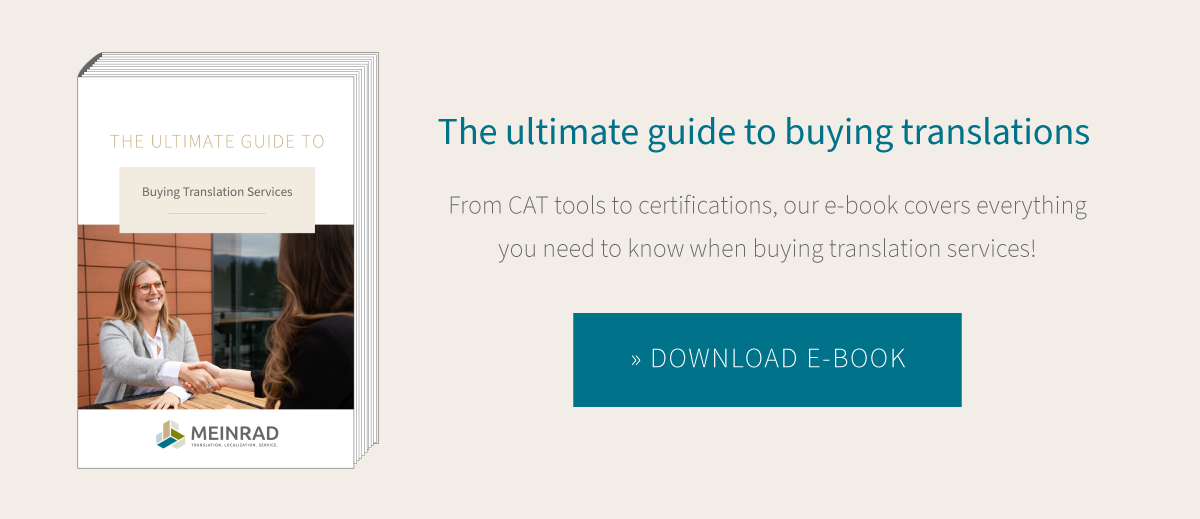
The decision has been made! You’re moving away from a decentralized, and often chaotic, process of buying translations and are looking to put a long-term structure in place – now there are a few things to bear in mind. Here’s our 5-point plan to make this transition a success.
Things often get messy at businesses when it comes to translations. Many people don’t know which or how many translation service providers are being used, or even which departments need translations in the first place – and inevitably, this means they lose track of costs. At some point those responsible for purchasing will become aware of this, and they’ll decide to do something about it. This is absolutely a good idea, because structured and well-negotiated framework agreements have a lot to offer:
- Less ongoing administrative burden
- Lower prices (the more work you give a service provider, the better rates they can offer)
- Maximum benefit from translation memories (so you pay less)
- Consistent, high-quality translations
- Opportunities for bulk or yearly discounts
- Full transparency and control over what you’re spending
- Legal protection
What’s required and how best to set up the team
But how do you go about structuring the process of buying translations? A crucial aspect is to have one person who’s ultimately responsible and serves as the brains behind the project, as it can take up to a year for everything to be in place and for your business to be ready to work with the new service provider(s). But this person can’t, and shouldn’t, handle everything on their own. Our experience has shown that a big step like this – which means everyone has to change how they work – can only succeed if everyone is on board and all their needs are factored in. For the new purchasing processes to work in the long run, all your colleagues need to be on the same page. It’s no use if the Purchasing department spends months looking for new service providers and chooses the best if others at your businesses make life awkward by not wanting to move away from the service provider they’re used to.
Ideally, the team for structuring your processes for buying translations should be made up more or less as follows:
- Consumers: They can give valuable insights into the process and system landscape requirements.
- Authors (technical authors, marketing): The people writing your documentation know exactly what matters in your source texts and what needs to be borne in mind for translation.
- Strategic alignment: The management team (e.g. sales managers) can explain the language needs you’ll have in the years to come and the countries where you have partners for in-country reviews.
- Purchasing: Your Purchasing department is in the best position to understand what your business needs from its service providers and knows your budget.
- Translation expertise:You need people who have expertise in the translation industry and in translation tools to fully understand the complex translation processes and what you can negotiate.
Making it happen
1. Get a full overview of your business budget and needs
Your first step should be to get a thorough overview of the status quo, i.e. which departments need translations. It’s often difficult to tell at first glance whether a department orders translations, because the costs can sometimes be swallowed up in the overall project costs – so a company-wide survey is essential. The survey should include questions on whether individual departments have and maintain translation memories or term bases/glossaries and whether there are lots of previously translated documents (worth bearing in mind for subsequent alignments). There should also be a section for evaluating the previous service providers you’ve used: if your colleagues are very happen with particular service providers, they can be included in the shortlist. Another important issue is to ascertain your translation costs for the last 3-5 years to give you a ballpark figure for the expected volume of work.
2. Establish and prioritize requirements
To make sure you choose the right service providers, you also need to establish what each department needs. Which departments need which translation processes (e.g. is machine translation with post-editing suitable or are creative marketing translations required)? What other needs are there, e.g. in terms of languages, IT security, system landscape, accessibility etc.? You then need to decide on which criteria have priority. All of the above serves as the basis for your discussions with the individual service providers – thorough preparation is the key to success!
3. Arrange to talk to service providers
With the key criteria in mind, you can screen potential service providers. You may have enough candidates in your pool of existing service providers who you can invite for in-depth discussions, otherwise you’ll need to publish an invitation to tender.
Before arranging these discussions, ask yourself the following:
Who should be involved in the discussions?
- It’s a good idea to have various people involved, rather than just the Purchasing team. The people with the most information at their fingertips and who will be most affected by the decisions you’re making should be there – so you may need a big discussion space as lots of people take the time to have their say! In hindsight you’ll be glad you did this, as the more people who are involved in making the decision, the more people will be fully behind it.
- You can simplify things by dividing the discussions into separate issues where only the relevant stakeholders take part.
- This is where the survey you carried out will help. Every issue brought up by your colleagues in the survey should be discussed with the translation service providers, whether it’s using machine translation, working with different file types, workflows, express jobs or whatever else.
4. Make the decision and draw up the framework agreement
Once you’ve carried out all the discussions and chosen the service provider(s), you should begin drawing up a framework agreement. This shouldn’t simply be a document that gets signed and then gathers dust on a shelf somewhere – it should genuinely benefit you in the real world on an ongoing basis. When drawing up the framework agreement, all consumers (heads of departments) should be involved and all issues that came up in the survey and in the previous discussions should be covered. These issues can include:
- Rates
- CAT grid
- Workflows
- Types of services
- File types
- Machine translation: yes or no?
- Use of software / sharing economy
- Interfaces
- Rights to translation memories
- Reporting
- Evaluation of the working relationship
As each department is likely to have different requirements, ideally they will each have their own section in the agreement to ensure everyone gets what they need. The agreement should be drawn up so that it benefits your everyday work – so all your staff should know what it contains and the processes and workflows resulting from it (a factsheet is a good way of doing this).
The exact content of a framework agreement should correspond to the following checklist:
5. Onboarding and starting to work together
The agreement can also set out the steps involved in the onboarding process and the associated obligations (e.g. whether staff need to be trained in how to use the customer portal, when interfaces will first be available, when existing term bases and translation memories will be accessible and so on). Once this is all agreed, you can look forward to a productive working relationship with your service provider(s).
Main Image: © Adobe Stock



